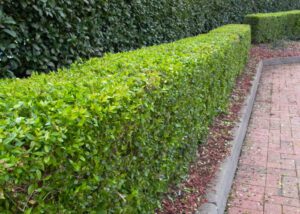Tree Trimming & Shrub Trimming
Pruning is the removal or reduction of certain plant parts that are not required, that are no longer effective, or that are of no use to the plant. It is done to supply additional energy for the development of flowers, fruits, and limbs that remain on the plant. Pruning, which has several definitions, essentially involves removing plant parts to improve the health, landscape effect, or value of the plant.
Pruning, like any other skill, requires knowing what you are doing to achieve success. The old idea that anyone with a chain saw or a pruning saw can be a landscape pruner is far from the truth. More trees are killed or ruined each year from improper pruning than by pests. Proper pruning enhances the beauty of almost any landscape tree and shrub, while improper techniques can ruin or greatly reduce its landscape potential. By using improper pruning methods, healthy plants are often weakened or deformed.
Tree Pruning

Pruning trees will help keep your yard or landscape healthier and have your trees looking the best they can. Tree trimming, or pruning, is more than just getting rid of dead limbs. It also helps the tree to grow new, healthy branches. Light pruning and the removal of dead wood can be done anytime, however, it is almost always best to trim or prune a tree during its dormant season.
Reasons to Trim or Prune a Tree:
Trees are generally trimmed for one of four purposes: aesthetics, safety, health, and maintenance.
- Aesthetics: Pruning a tree effectively helps to maintain its shape and appearance.
- Safety: Dead or broken branches and limbs can fall off at any time, which is a serious safety hazard. If the branches of a tree obstruct the vision of drivers in your neighborhood, they should be trimmed away.
- Health: It is sometimes possible to save an infected tree by strategically pruning away affected branches and limbs. Thinning the crown of a tree improves airflow, which can be very beneficial if branches are crossing or rubbing together.
- Maintenance: Tree trimming is also done as a preventative measure to keep branches from damaging home and building structures or overhead lines.
Fruit Tree Pruning
Fruit tree pruning covers a number of horticultural techniques that control growth, remove dead or diseased wood and stimulate the formation of flowers and fruit buds. The time of year and technique to pruning fruit trees can vary greatly from the time and technique for non-fruit trees. Pruning techniques also vary between the different types of fruit trees.
Hedge and Shrub Trimming
Pruning during dormancy is the most common practice. It results in a vigorous burst of new growth in the spring and should be used if that is the desired effect. It is usually best to wait until the coldest part of winter has passed.
Renewal Pruning
Renewal pruning consists of removing up to one-third of the oldest, thickest stems or trunks, taking them right down to the ground. This will encourage the growth of new stems from the roots. Once there are no longer any thick, overgrown trunks left, standard pruning is applied as needed.
Rejuvenation Pruning
Older shrubs often grow out of proportion with their surroundings and may have large amounts of unproductive wood. Older shrubs receive rejuvenation pruning provided they still have sufficient vigor and are growing in a favorable location.
Pruning Hedges
After the initial pruning at planting, hedges need to be pruned often. Once the hedge reaches the desired height, new growth needs to be pruned every 6 to 8 inches. Hedges may be pruned two to three times a year to keep them dense and attractive.
Let the Pros Handle the Pruning
Contact us to schedule shrub trimming, tree or hedge pruning services as a one-time service or on a recurring basis. Our pruning specialists will keep your trees & shrubs healthy, beautiful, and safe.

